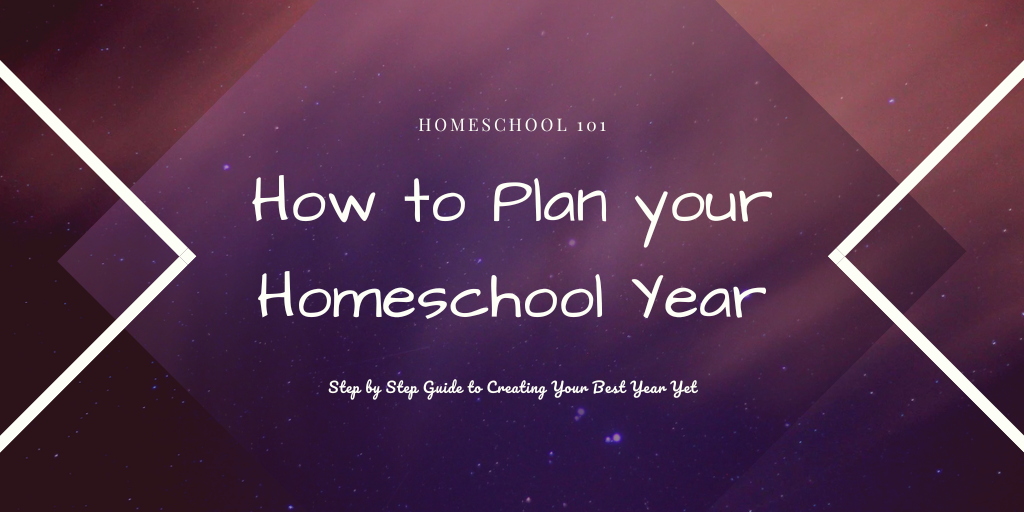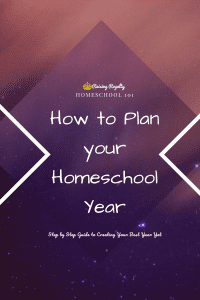
Are you ready to plan your homeschool year?
Every year, starting in late February or early March, I start planning my next homeschool year. It’s an easy enough process, though it does take time. Planning your homeschool includes figuring out your schedule, your topics and skills to teach, choosing materials, then putting it all together. Here’s how to plan your homeschool year.
1. Choose your school year dates.
Grab a calendar for the next 18 months or so, and a pen. It helps if you have one of those calendars that has the year all on one page (like in my Plan your Day Planner).
Look ahead and circle the date you will be ending this year. For me, that’s usually in July, as we do a loose year-round schedule. We usually end close to July 15th.
Then, figure out when next year will start. For us, this will be the day after Labour Day, here in Canada. We usually take 6-8 weeks off for a “summer vacation”.
You don’t have to follow a typical public school calendar. You could have a July to May schedule, or an October to August? Or maybe you’ll follow the calendar, and go January to December.
Whatever you choose, circle those days on your calendar, and write them down.
2. Choose your vacation days.
Now that we have a start and end date, it’s time to plug in how many days we’ll be “in school”. For those who have state regulations requiring so many days in the year, keep that in mind as you plan when you’ll be taking time off.
For us, we don’t have any regulations about attendance, so it’s more what I’m comfortable with, and when we need a lighter schedule.
For example, we always take the month of December off. We have a family birthday and we go big on Christmas celebrations, so there’s a lot going on. It’s just easier to be a little more flexible.
The same goes for April. In April, we have a family birthday, and (usually) Easter. We tend to take April off, depending on when Easter falls that year.
As I said previously, we take 6-8 weeks for summer, as in Canada, summers are short!
Depending on how school is going, or if we have family plans, we may take a week at Thanksgiving (in October, because we’re in Canada!) and a week in February.
Take vacations and long weekends where it makes the most sense for your family. When you plan your homeschool year, take advantage of the flexibility!
3. Choose your weekly schedule.
You don’t have to “do school” 5 days a week, as is traditional. You could do a 4-day week, and keep an extra day in the week for a longer weekend, or for a flex day for appointments, errands and field trips. You could do a 6-day week, and stay on routine, if that makes it easier for you.
For us, we do a more traditional 5-day week most often, though I’ve had a 4-day school week in the past. But for now, a 5-day week is what I’ll plan on for next year.
4. Choose your daily schedule.
We have a loose daily routine here, rather than a set daily schedule. Generally “school” takes us about 3 hours, depending on wiggly-ness and the interruptions of the day.
This past year, we’ve done school mostly in the mornings, and I plan on sticking with that for next year. In previous years, I’ve done schooling in the afternoons when I had younger children napping. Or in the evenings, when everyone was more able to listen and focus as their bodies quieted down.
Some people may want to be more detailed with their daily schedule, setting aside time for specific activities like read-alouds or math lessons.
Figure out what works for you in planning your homeschool.
5. Make adjustments in your methods.
If this is your first full year of homeschooling, you’ll want to learn more about homeschool methods before going on to this step.
If you know your preferred method of homeschooling, then this is a simple step. All you do here is take a moment to review. What’s working and what isn’t?
For example, we do a lot of project-based science and history in our homeschool. But for my special needs daughter, the project plans were too complicated and overwhelming. So last year, we switched to a simpler text-book based science program that she has been enjoying and excelling in.
Making adjustments just means figuring out what’s going to work best in your homeschool. Remember to stay flexible!
6. Evaluate your kids’ learning.
This step usually takes me a few weeks, so I usually do it in my April break.
In this step, I’ll take a look at what we’ve been doing, and how well my kids have progressed. Is there an area where the material we’ve been using isn’t challenging enough, and it’s boring now? Or is there a skill that needs more practice? Maybe there’s something that has sparked a lot of interest, so we could extend that topic?
I don’t necessarily use tests or reports, but I do assess where we’re at. Usually, I’ll compare our goals for this year to what we’ve actually learned.
7. Set new goals for your kids’ learning.
Once I have a good picture of where my kids are at, I’ll pull out my goal planning sheets, and start planning our learning goals for next year. I have a set list of skills and topics year by year, and I use those to help me set goals for every child.
This helps with the next step in planning homeschool. And since this all happens in April, typically, it’s right in time for homeschool conventions too.
8. Choose materials.
Now that I know where we are and where I want to go with my kids, I can choose the materials that will get us there. We don’t use an all-in-one curriculum, though that’s definitely a great way to go. But I prefer to customize everything for my kids, so I can best support their challenges and challenge their strengths.
I do have a set of preferred curriculum materials though. For example, I really like the Rod and Staff spelling curriculum for elementary grades. So for most of my kids’, we’ll just get the next level for them. For math, I use Math Mammoth, so it’s just a matter of printing out the next set of books.
Sometimes, though, I need to do some research and find a new curriculum, material, program or book to meet my goals and my kids’ needs. I will usually start with my favorite homeschool review site, CathyDuffyReviews.com, and search my own bookmarks and files for anything relevant. Then I’ll attend a conference or convention, and check our local homeschool book store.
9. Planning the lessons.
Once I’ve chosen and ordered or printed all my homeschool materials, I start planning them out. Ordering and printing can take weeks, so I usually don’t get to this step until my summer break.
I start by figuring out how many actual days I plan to do school. Basically, I count up the weeks between my start date and my end date, subtract 9-10 weeks, then multiply by 5 (for a 5-day school week). That gives me my total — usually between 170-200 days in school, depending on the year.
So I don’t plan out lessons on a day-by-day basis. In other words, I don’t date my planning!
Instead, I will determine what will be a “daily assignment” in any particular topic, skill or “subject” that I want to cover this year. For example, how many pages of math or how many pages to read in our reader will be a “daily lesson”? I will create a list of lessons to check off throughout the year.
For some things, it’s easy. The publishers already separated out their material into daily lessons, so for me, it’s just listing out how many lessons are in that particular book.
For others, it’s a bit more involved. Our history curriculum often uses lapbooks and a combination of stories, non-fiction books, documentaries and other activities to explore the topic. So for these lessons, I’ll figure out which activity we’ll do, and in what order. I’ll write out my lessons in a numbered list, rather than a dated list (Day 1, rather than September 10th).
I compile all my lesson lists into a notebook and then save them for the next year.
10. Get supplies & set up!
So by now it’s getting close to our start date, in late August. I’ll start by cleaning out all our old supplies, getting rid of short stubby pencils, broken ruler pieces, dull scissors, empty glue sticks and dry markers. Then I’ll sort out everything into it’s proper containers, and clean all the surfaces from leftover eraser bits and pencil shavings.
Then we restock. I get craft supplies and cardstock, new pencils, sharpeners, scissors and glue sticks, extra stickers, and anything else we might need for the next year. Since this is right when back-to-school shopping is nearly over, it’s easy to hit up the clearance sales!
Then I set out the new books for each child on their shelf and in their boxes, and pull out my weekly planner sheets. I create our first set of weekly lesson plans from my lists.
And we’re all set.
That’s how I plan my homeschool.

